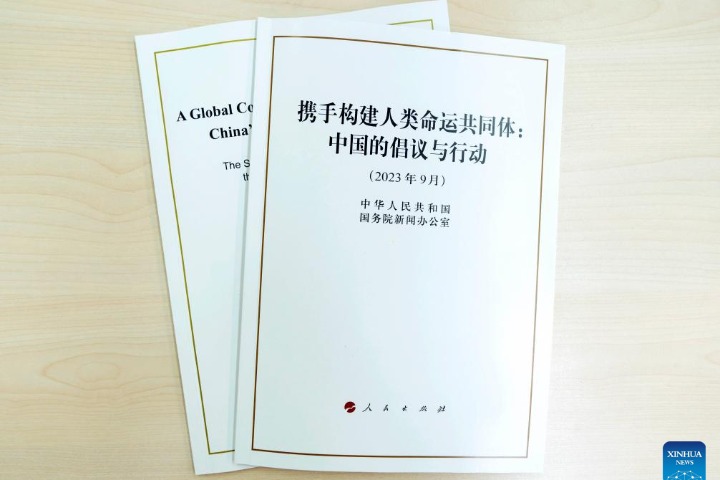新疆的人口发展(双语全文)
新华网 2021-09-26 15:05

二、新疆人口的现状
II. Latest Demographics of Xinjiang
2020年第七次全国人口普查初步汇总数据显示,新疆总人口2585.23万人,汉族人口1092.01万人,少数民族人口1493.22万人。与第六次全国人口普查相比,10年间,新疆人口增速居全国第4位,人口增量居全国第8位,人口总量的排位由第25位上升到第21位。
According to preliminary data from the seventh national census in 2020, the total population of Xinjiang was 25.85 million, among which the Han ethnic group numbered 10.92 million, and ethnic minorities 14.93 million. Compared with the data from the sixth national census in 2010, Xinjiang ranked fourth among 31 provinces and equivalent administrative units on China’s mainland in terms of the population growth rate. It ranked eighth in terms of the actual increase in population over that period. By 2020, Xinjiang’s total population ranking had risen from 25th to 21st in the country.
从性别结构看,新疆人口中,男性人口1335.44万人,占总人口的51.66%;女性人口1249.8万人,占总人口的48.34%;总人口性别比(每100名女性相对应的男性人数)为106.85,与第六次全国人口普查基本持平。
Gender composition: Of Xinjiang’s population in 2020, 13.35 million (51.66 percent) were male while 12.5 million (48.34 percent) were female. The male to female ratio was 106.85:100, basically the same as in 2010.
从年龄结构看,新疆0-14岁人口580.62万人,占22.46%;15-59岁人口1712.92万人,占66.26%;60岁及以上人口291.7万人,占11.28%。与2010年相比,0-14岁人口比例上升2.01个百分点,60岁及以上人口比例上升1.62个百分点。与全国平均水平相比,新疆0-14岁人口比例比全国的17.95%高4.51个百分点;60岁及以上人口比例比全国的18.7%低7.42个百分点,人口的老龄化程度相对较低。
Age breakdown: In 2020, there were 5.81 million in the 0-14 age group, accounting for 22.46 percent; 17.13 million in the 15-59 age group, accounting for 66.26 percent; and 2.92 million in the age group of 60 and above, accounting for 11.28 percent. Compared with 2010, the proportions of people in the age groups from 0 to 14, and 60 and above were up by 2.01 and 1.62 percentage points. In 2020, Xinjiang’s share of people in the 0-14 age group was 4.51 percentage points higher than the national average of 17.95 percent; and its share of people in the age group of 60 and above was 7.42 percentage points lower than the national average of 18.7 percent. The aging of its population was relatively moderate.
从受教育程度看,新疆15岁及以上人口的平均受教育年限由2010年9.27年提高至2020年10.11年,比全国人口平均受教育年限9.91年高出0.2年,居全国第10位。与2010年相比,每10万人口中拥有大学文化程度的由10613人增加到16536人;拥有高中文化程度的由11669人增加到13208人;拥有初中文化程度的由36241人降低至31559人;拥有小学文化程度的由30085人降低至28405人。
Education: The average years of schooling for people aged 15 and above rose from 9.27 years in 2010 to 10.11 years in 2020, 0.2 years higher than the national average of 9.91, and ranking 10th across the nation. Compared with 2010, the number of people with university education rose from 10,613 to 16,536 per 100,000 persons; those with high school education grew from 11,669 to 13,208; those with middle school education dropped from 36,241 to 31,559; and those with primary education fell from 30,085 to 28,405.
从健康水平看,新疆人口2019年平均预期寿命74.7岁,比2010年提高2.35岁。婴儿死亡率、5岁以下儿童死亡率、孕产妇死亡率分别由2010年的26.58‰、31.95‰、43.41/10万降至2020年的6.75‰、10.91‰、17.89/10万。2019年每千人执业医师数和医疗卫生机构床位数分别达到2.7人和7.39床,分别比2010年增加了0.58人和1.93床。
Health: The average life expectancy of people in Xinjiang was 74.7 in 2019, up 2.35 years from 2010. Infant mortality rate, mortality rate for children under five years of age, and maternal mortality rate went down from 26.58 per 1,000, 31.95 per 1,000, and 43.41 per 100,000 in 2010 to 6.75 per 1,000, 10.91 per 1,000, and 17.89 per 100,000 in 2020. In 2019, practicing doctors and hospital beds per 1,000 persons numbered 2.7 and 7.39, up 0.58 and 1.93 over 2010.
从城乡和流动人口结构看,2020年新疆城镇人口1461.36万人,乡村人口1123.87万人,分别占总人口的56.53%、43.47%。与2010年相比,城镇人口增加527.79万人,乡村人口减少124.13万人,城镇人口比例上升13.73个百分点。新疆流动人口805.14万人。其中,疆内流动人口466.07万人,跨省流入人口339.07万人。与2010年相比,流动人口增加406.11万人,增长101.78%。
Rural, urban and floating populations: In 2020, there were 14.61 million people living in the urban areas of Xinjiang, accounting for 56.53 percent; 11.24 million living in the rural areas, accounting for 43.47 percent. Compared with 2010, the urban population increased by 5.28 million and the rural population decreased by 1.24 million. The share of urban population went up by 13.73 percentage points. As of 2020, the floating population in Xinjiang numbered 8.05 million, with 4.66 million moving within the autonomous region and 3.39 million moving to Xinjiang from other parts of the country. Compared with 2010, the floating population grew by 4.06 million, an increase of 101.78 percent.
从区域分布看,新疆现有14个地(州、市),其中,北疆9个、南疆5个。历史上,南北疆人口数量相差较大,南疆人口一度占全疆人口的三分之二以上。随着经济社会的发展,南北疆人口分布趋于平衡。2020年,北疆人口1330.91万人,占总人口的51.48%,比2010年的1135.29万人,增加195.62万人;南疆人口1254.32万人,占48.52%,比2010年的1046.29万人,增加208.03万人。
Regional distribution: Xinjiang now has 14 prefectural-level areas – 9 in northern Xinjiang and 5 in southern Xinjiang. In the past, there was a big population gap between north and south. The population of southern Xinjiang once accounted for over two thirds of the region’s total. This gap has been gradually bridged thanks to economic and social development. In 2020, the population of northern Xinjiang was 13.31 million, making up 51.48 percent of the total, up by 1.96 million from 11.35 million in 2010. The population of southern Xinjiang was 12.54 million, accounting for 48.52 percent of the total, an increase of 2.08 million from 10.46 million in 2010.
三、维吾尔族人口的发展
III. Demographic Changes in the Uygur Population
新中国成立以来,新疆进入和平发展时期。1955年,新疆维吾尔自治区成立,党和国家在新疆实行民族区域自治制度,坚持各民族一律平等,实施一系列特殊扶持政策,维吾尔族等少数民族人口进入了历史上最好的发展时期。
Xinjiang has enjoyed peace and development since 1949. After the Xinjiang Uygur Autonomous Region was established in 1955, the CPC and the central government implemented regional autonomy to ensure the equal status of all ethnic groups, and adopted a series of preferential policies to assist and support regional development. Ethnic minority groups in Xinjiang, including the Uygurs, entered an optimal period for development.
从人口增长看,新疆维吾尔族人口持续增长。根据历次全国人口普查数据,维吾尔族人口1953年为360.76万人,1964年399.16万人,1982年595.59万人,1990年719.18万人,2000年834.56万人,2010年1000.13万人,2020年1162.43万人。每两次普查间净增人口分别为38.4万人、196.43万人、123.59万人、115.38万人、165.57万人、162.3万人,年均增长率分别为0.92%、2.25%、2.38%、1.5%、1.83%、1.52%。
The Uygur population in Xinjiang has continued to grow.

上述数据表明,新中国成立后,维吾尔族人口总体保持较高增长水平,与新疆人口发展的趋势基本一致。
These data show that since the founding of the PRC, the Uygur population has maintained a relatively high growth rate, a trend shared with the total population growth of the region.
进入新世纪以来,维吾尔族人口从2000年的834.56万人增长至2020年的1162.43万人,年均增长率1.67%,远高于同期全国少数民族人口年均增长率0.83%的水平。
In particular, the Uygur population grew at a CAGR of 1.67 percent during the first two decades in the 21st century, which was much higher than that of the country’s ethnic minority population, which stood at 0.83 percent.
从年龄结构看,维吾尔族人口与全疆人口相比,年龄结构轻。2020年维吾尔族0-14岁、15-59岁、60岁及以上人口占比分别为30.51%、60.95%、8.54%。2020年全疆0-14岁、15-59岁、60岁及以上人口占比分别为22.46%、66.26%、11.28%。
The Uygur population is on average younger than the overall region. In 2020, in the 0-14, 15-59, and 60 and above age groups, the Uygur proportions were 30.51 percent, 60.95 percent and 8.54 percent, while the overall figures for the region were 22.46 percent, 66.26 percent and 11.28 percent.
从受教育程度看,维吾尔族受教育水平不断提高。第七次全国人口普查数据显示,维吾尔族每10万人中拥有大学文化程度的人口为8944人,与2000年相比增加6540人,15岁及以上人口受教育年限从2000年的7.06年提高到2020年的9.19年。
The education level of the Uygur population has also continued to improve. According to data from the seventh national census in 2020, 8,944 per 100,000 Uygurs had received a university education, an increase of 6,540 compared to 2000. The average years in education for those aged 15 and above also grew from 7.06 to 9.19.
从区域分布看,维吾尔族人口主要分布在喀什、和田、阿克苏、克州等南疆四地州。据2020年全国人口普查数据,南疆四地州维吾尔族人口占当地人口的83.74%,占全疆维吾尔族人口的74.01%。其中,喀什、和田等地区,维吾尔族人口在200万以上,阿克苏地区接近200万。
Xinjiang’s Uygurs are mainly distributed in Kashgar Prefecture, Hotan Prefecture, Aksu Prefecture, and Kizilsu Kirgiz Autonomous Prefecture in the southern part of the region. According to data from the 2020 national census, Uygurs accounted for 83.74 percent of the population in these four prefectures, representing 74.01 percent of the total Uygur population in Xinjiang. The Uygur population has surpassed 2 million in both Kashgar and Hotan, and is approaching 2 million in Aksu.

















 英语点津微信
英语点津微信 双语小程序
双语小程序